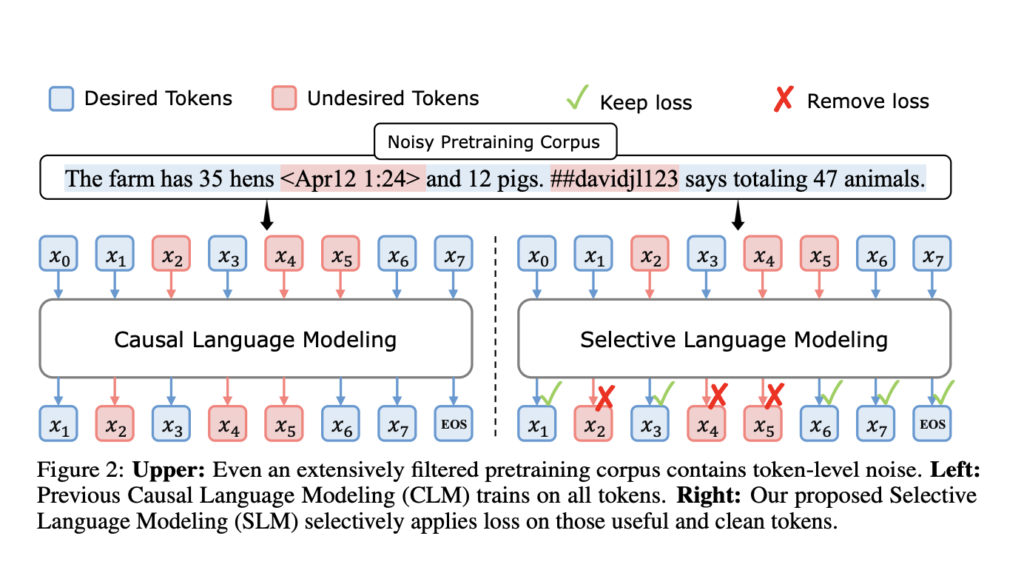
In artificial intelligence, especially in language processing, consistent advances have been made by scaling model parameters and dataset sizes. Notable advances in training language models have traditionally relied on the widespread application of next-token prediction tasks across all training tokens. Despite the wide application of these techniques, the assumption that all tokens in a dataset contribute equally to the learning process is under increasing scrutiny. If the model is trained uniformly across all tokens, there will be significant inefficiencies, many of which may need to be more important to the model’s performance and learning efficiency.
Existing research includes optimizing the training of language models through strategic data selection and curriculum learning. Traditional models like BERT utilize heuristic filters to improve data quality and impact the generality of the model. Innovations such as masked language modeling (MLM) focus on predicting a subset of tokens to increase training efficiency. Research also investigates token-level dynamics, identifying “easy” and “hard” tokens that influence learning trajectories. This foundational work underpins advanced methodologies and paves the way for more intensive training approaches that maximize the efficiency and effectiveness of language models.
Researchers from Xiamen University, Tsinghua University, and Microsoft introduced RHO-1, which employs selective language modeling (SLM). This new approach optimizes language model training by selectively focusing on tokens that have a significant impact on learning efficiency. Unlike traditional models that treat all tokens equally, RHO-1 identifies and prioritizes “high utility” tokens, increasing training efficiency and model performance with less computational resource consumption.
The RHO-1 methodology begins by training a reference model using a high-quality dataset to evaluate the usefulness of the token. The model scores tokens and identifies those that are most useful for intensive training. The subsequent training phase includes only these selected high utility tokens. This process was applied to the OpenWebMath corpus consisting of 15 billion tokens and provided a comprehensive basis for evaluating the efficiency of RHO-1. By focusing on key tokens, RHO-1 maximizes computational resources and model learning efficiency, streamlining the training process and improving model performance on the target task.
Implementing Selective Language Modeling (SLM) within the RHO-1 model significantly improved performance. Specifically, the RHO-1-1B model demonstrated up to 30% absolute improvement in few-shot accuracy across nine mathematical tasks when trained on the OpenWebMath corpus. To further prove the effectiveness of SLM, after fine-tuning, RHO-1-1B achieved the highest score of 40.6% on the MATH dataset. Meanwhile, the larger RHO-1-7B model achieved an even higher accuracy of 51.8% on the same dataset. These models reached baseline performance up to 10 times faster than models trained using traditional methods. This difference in performance between the RHO-1-1B and RHO-1-7B models clearly demonstrates the scalability and effectiveness of SLM across different model sizes.
In conclusion, this study introduces the RHO-1 model that employs selective language modeling, developed through a collaboration between Xiamen University, Tsinghua University, and Microsoft. RHO-1 increases efficiency by selectively focusing on tokens with high utility. SLM has demonstrated that using a reference model to score and select tokens for training significantly increases model efficiency and accuracy, as evidenced by improved performance on the OpenWebMath corpus. This result confirms that focusing training on the most influential tokens leads to faster learning and more accurate model performance, making SLM a valuable advance in artificial intelligence.
Please check Paper and Github. All credit for this research goes to the researchers of this project.Don’t forget to follow us twitter.Please join us telegram channel, Discord channeland linkedin groupsHmm.
If you like what we do, you’ll love Newsletter..
Don’t forget to join us 40,000+ ML subreddits
Want to get in front of an AI audience of 1.5 million people? work with us here

Nikhil is an intern consultant at Marktechpost. He is pursuing an integrated dual degree in materials from the Indian Institute of Technology, Kharagpur. Nikhil is an AI/ML enthusiast and is constantly researching applications in areas such as biomaterials and biomedicine. With a strong background in materials science, he explores new advances and creates opportunities to contribute.

